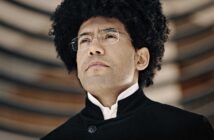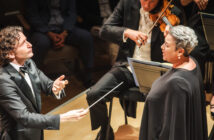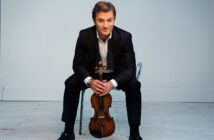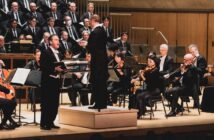J.S. Bach: St. Matthew Passion BWV 244
John McVeigh, tenor
Morgan Smith, baritone (Christus)
Camilla Tilling, soprano
Jennifer Johnston, alto
Johannes Chum, tenor (Evangelist)
Alistair Miles, bass
Dallas Symphony Chorus, Joshua Habermann, director
Children’s Chorus of Greater Dallas, Cynthia Nott, director
Dallas Symphony Orchestra, Jaap van Zweden, conductor
Meyerson Symphony Center
Dallas, Texas
Friday, March 29, 2012
Jaap van Zweden, recently named “Conductor of the Year” by Musical America, has been recognized by music-lovers in Dallas since 2008 – the start of his music directorship of the DSO – as an extraordinary leader of musicians. He has impressed audiences and critics alike in the “Big D” with his readings of Tchaikovsky, Mahler, Bruckner and Shostakovich, remarkable for their intensity and high performance standard.
But the music of Bach, especially the St. Matthew Passion, is something else again. The forces here are large but they are rarely powerful. No trumpets, trombones or percussion required for this piece. This music needs a lighter touch, deep insight into the sacred texts, and a performing style that is historically accurate. Tonight’s performance revealed to Dallas audiences this other side of Jaap van Zweden, and again he proved masterful on the highest level. For this listener, it was a performance for the ages, full of beauty and insight from beginning to end.
Once again, we must remember that much of van Zweden’s musical education took place during his eighteen years as concertmaster of the Royal Concertgebouw Orchestra in Amsterdam. Sitting in that orchestra, van Zweden worked with some of the finest conductors of his generation – among them Nikolaus Harnoncourt, (photo: right) a man renowned for his painstaking work on performance practice in music from the Baroque and Classical periods. Van Zweden has frequently mentioned that he learned a great deal from Harnoncourt about how this music should be played, but this performance was not simply a matter of copying what Harnoncourt did.
Masterminding a Historically Accurate Performance
The understanding of historically correct performance practice has evolved over time and will continue to evolve as scholars and scholar-performers like Harnoncourt, Gardiner, Koopman, Herreweghe and others dig deeper. Harnoncourt himself, for example, recorded the St. Matthew Passion no fewer than three times between 1970 and 2000 and each performance is different. In other words, to say that van Zweden learned from Harnoncourt is only to say that van Zweden learned from him a great deal about period performance practice as a starting point for his own study. What we heard in Dallas was not a St. Matthew Passion modeled on Harnoncourt but a living, breathing performance that only van Zweden and his singers and players could have given.
On this occasion, Van Zweden was limited by the fact that he had only a week of rehearsals, that he was working with musicians playing on modern instruments, and that these musicians were largely inexperienced with this style of performance. He asked the string players to use much less vibrato and a lighter and more nuanced bowing style than they were accustomed to using. In addition, he penned all manner of dynamic markings in their parts. He even changed the length of some of the notes in the score, often shortening long notes in accordance with period style, thus allowing for greater clarity. He frequently delineated cadences at the end of phrases with Luftpausen,literally a “lift” of the bow before the cadence.
The winds sounded different too. Van Zweden expressed a preference for the more mellow sound of wooden flutes as compared to the metal flutes used in most orchestras today, and the DSO flutists obliged him by using wooden ‘head joints’ (photo: left), the part of the flute with the mouthpiece.
All these touches are the stuff of historically authentic performances. We should also mention the generally faster tempi and modest chorus and orchestra sizes favoured by van Zweden in accordance with what is now known about what would have been done in Bach’s time. Record buffs can make their own comparisons between any of the Harnoncourt or Gardiner recordings and the older ones by Mengelberg, Klemperer or Karajan. The words ‘grandiose’ and/or ‘lugubrious’ come to mind when describing these traditional performances
Outstanding Musicians and Soloists Rise to the Occasion
Strict adherence to scholarly practice does not in itself guarantee a great performance of anything, let alone a work as profound as the St. Matthew Passion. One still requires excellent singers and musicians and a conductor who can put such a complex piece together and make it compelling; thankfully, we had all these things and more on this night in Dallas.
Let’s start with the man telling the story in Bach’s Passion. The Evangelist, as he is called, needs to have the most flexible of tenor voices and a compelling presence. The Austrian tenor Johannes Chum (photo: right) was that man and I never expect to hear a finer performance. He never shouted, sobbed or waved his arms about. He simply sang the music and conveyed the meaning of the words. That was more than enough. His rendering of the passage in which Peter vehemently denies Jesus, not once but three times, was heartbreaking, especially on the words “Und ging heraus und weinete bitterlich” (And he went out and wept bitterly).
Baritone Morgan Smith sang the role of Christus (Jesus) with great dignity and again, let the music and the words speak for themselves.
The solo arias contain enormous expressive and technical challenges; soprano Camilla Tilling sang them beautifully, with near-perfect control. Even more impressive was alto Jennifer Johnston (photo: left). Her rendering of the celebrated aria “Erbarme dich” was poignant beyond description, and the orchestral accompaniment led by concertmaster Alexander Kerr was sublime. I can’t imagine how Jaap van Zweden got the strings to play their sustained notes so softly. The pizzicato in the double basses was exactly what was needed – loud enough to mark the rhythm but not so loud that it obtruded on the hushed sadness Bach so obviously wanted here. Kerr’s solo playing displayed a flawless technique and beautiful tone, always, as we might say, ‘within the frame.’ This great solo does not require the heavy richness of tone we associate with Brahms or Tchaikovsky. In fact, that kind of playing would destroy the purity of Bach’s conception, not to mention be stylistically misguided.
Bass Alastair Miles was a tower of strength. His great solo “Mache dich” was sung with effortless command of the long lines and with a richness of tone that reminded me of Tom Krause in his prime. Tenor John McVeigh was another solid performer apart from a few brief moments of strain in his upper register.
Incidentally, another superb violinist, Emanuelle Boisvert, until recently concertmaster of the Detroit Symphony, led the second orchestra in this performance. She too contributed some fine solo playing in her accompaniment of the bass aria “Gebt mir meinen Jesum wieder.”
The Dallas Symphony Chorus, under its newly-appointed director Joshua Habermann (photo:right) has had very little experience with this repertoire in recent years, but rose to the occasion. This is not Carmina Burana or the Beethoven Ninth. The St. Matthew Passion requires very controlled and disciplined singing and the chorus must have worked hard to master it. The Children’s Chorus of Greater Dallas were similarly well-prepared and sang very well indeed. Too bad Bach didn’t call for children’s voices in Part Two.
Guest Continuo Trio a Perfect Choice
In between the arias and choruses in the St. Matthew Passion are pages of recitative in which the soloists are accompanied only by a continuo group, on this occasion comprised of William Skeen (viola da gamba), Phoebe Carrai (cello) and Hanneke van Proosdij (organ). These players were borrowed from the Philharmonia Baroque Orchestra in San Francisco and they were superb. Their parts are pretty unobtrusive except when they are not perfect. These musicians were perfect and enhanced the performance immeasurably. William Skeen was also very impressive in two of the arias, particularly the bass aria “Komm, süsses Kreuz.”
Two Orchestras Double Heavenly Sound
There are two choruses and two orchestras in the St. Matthew Passion. Each orchestra has two flutes, two oboes and strings. The oboists are sometimes called upon to play other instruments, namely either an oboe d’amore or an oboe da caccia. In this performance the oboe d’amore parts were played by Erin Hannigan (photo:left) and Brent Ross, and the oboe da caccia parts were played on English horns by David Matthews and Willa Henigman. All four players were outstanding and one marveled anew at Bach’s musical imagination in the use of these instruments. Especially memorable was the soprano aria “Aus Liebe” in which the sole orchestral accompaniment is a flute and a pair of oboes da caccia (English horns), and the extraordinary alto aria “Sehet, sehet” with a pair of oboes da caccia and continuo. The singing and playing in both cases was heavenly.
Chorales Simple and Profoundly Moving
Lutheran chorales are used throughout the work to break up the storytelling and to involve the congregation. At least that was the intention in Bach’s time. As in so much of the music in the St. Matthew Passion, Bach indicated neither tempo nor dynamics. In traditional performances these chorales were often taken very slowly and encumbered with all manner of interpretive glosses as if to underline their seriousness. Early music specialists tend to play these in a more straightforward manner, treading lightly with swells and fades. Van Zweden is of the latter persuasion. Now and again he allows himself stress on a word or phrase but for the most part he plays the chorales simply and definitely without sentimentality.
English Surtitles Engage Listeners: Thankyou!
This evening’s performance was given in the original German, with surtitles in English – a wonderful idea which allowed each listener to follow the story and to be fully engaged. Bach’s audience would, of course, have understood every word, and to present a performance of the St. Matthew Passion in 2012 without meeting that same standard would be to totally misrepresent this great masterpiece. There are only two acceptable options today: either translate the work to the language of the audience, or present it in the original German, with surtitles.
As usual, Laurie Shulman’s program notes were thorough, scholarly and very helpful. I don’t know many orchestras that go to the trouble of commissioning such exemplary notes week in and week out. For this performance of the St. Matthew Passion there were no fewer than nine pages of notes!
For further Listening and Reading…
Nikolaus Harnoncourt’s most recent recording of the St. Matthew Passion is available on Teldec 8573-81036-2. The set also contains a bonus CD-ROM devoted to Bach’s 1736 autograph manuscript. Listeners can put the CDs on their stereo player and follow the score using their computer. Some of Harnoncourt’s thoughts on the work are included in his book The Musical Dialogue, published by Amadeus Press in 1989.
There are several recordings available in English. One of the most interesting was done by Leonard Bernstein with the New York Philharmonic in 1963. It is an abridged version but it is dramatically compelling. The CD set also contains an illustrated discussion of the work by Bernstein (Sony SM2K 60727).
Paul E. Robinson is the author of Herbert von Karajan: the Maestro as Superstar, and Sir Georg Solti: His Life and Music. For friends: The Art of the Conductor podcast, Classical Airs. Click here for a Classical Conversations video (Paul and Maestro Jaap van Zweden discuss Bach’s St. Matthew’s Passion).
Jaap van Zweden: Photos by Marita














